Black Diamond Equipment Uses NX Shape Studio to Design New Ski Boots
A newcomer to the ski-boot business used NX Shape Studio to create a line of boots that challenge products from companies with more than 50 years of experience.
Latest News
September 1, 2008
By Caren Potter
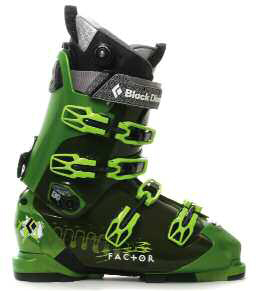 The Factor is one of nine new models of ski boot from Black Diamond, newcomers to a crowded boot-making industry. Designers used Siemens NX software to create a line that has backcountryskiers buzzing. |
Black Diamond Equipment Ltd., an employee-owned company in Salt Lake City, makes equipment for climbing and backcountry skiing. Its designers are enthusiasts in the sports they design for and, as a result, Black Diamond’s equipment regularly wins awards for its innovation and quality.
Several years ago, Black Diamond decided to apply its expertise to a new area — freeride ski boots. The company, which had never made a boot before, saw a gap in gear used by a niche group in the skiing world who like to climb up mountains untouched by mechanical lifts to ski down on untouched snow. In many cases, this means strapping skis to a backpack and hiking up in stiff plastic Alpine ski boots. In other cases, it means “skinning” up on skis with free heels (telemark) or on alpine touring (AT) gear where the heel is raised for the climb and locked down into the binding for the descent. To make things more comfortable and more functional, the idea was to design a boot that acts like a hiking boot for the climb up and still has the performance of an alpine ski boot for the ride down.
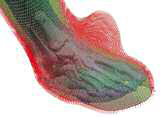 This image, used for developing the last on which the boot will be based, combinesscans of boots, feet, and existing shoe lasts. |
One of Black Diamond’s goals was to combine the two sets of performance criteria in one great-looking boot. “The other freeride boots out there are made by European competitors with 50-plus years of boot-making experience,” says David Narajowski, director of advanced projects at Black Diamond. “Our challenge was not just to catch up to where they were, but to go beyond and create something much better.”
In all, the company designed nine models, three for AT and six for telemark.
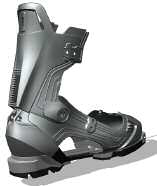 The internal structure of the boot reveals the hinged ankle, two buckle anchors, and the integrated mount for the lockable ski-walkdevice located just above the heel. |
Integrated Concept and Product Design
Black Diamond’s designers historically used I-deas, from Siemens PLM Software, to develop many of its successful products. At the time the boot project started, however, the company decided to standardize on the Siemens NX digital product development system, which would allow it to leverage its legacy I-deas data.
“Between I-deas and NX, there was a period of time when we tried a mid-range CAD program,” Narajowski says. “But there is no way we could have developed a freeride boot in a mid-range system.”
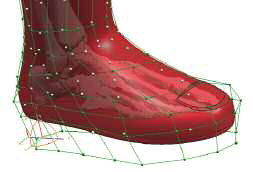 Development of the last continued with Shape Studio, the free formmodeling capability in NX. |
One of NX’s main advantages, according to Narajowski, is that it provides both the freeform modeling capability needed to capture the company’s design expertise (through the NX Shape Studio application, offered as part of the NX Mach III industrial design solution) as well as the product design tools needed to turn an idea into a manufacturable product.
“This is a perfect combination for Black Diamond’s hands-on, chopshop-inspired, fail-fast-to-succeed-sooner approach to design,” says Narajowski. “Working with NX Shape Studio, we can directly manipulate surface geometry to do things like capture anatomical nuances of the foot. And this functionality is integrated with NX product design tools such as WAVE that let us go from one original conceptual model to three different product families with 10 sizes each.
Jake Hall, Black Diamond’s lead industrial designer on the project, explains the need for such tight integration this way: “One of the great challenges of designing ski boots is that there is very little separation between performance and aesthetics. Fit, performance, and aesthetics are one and the same. This means that engineering, industrial design, and manufacturability must be tied together seamlessly in order to create a successful product. Any apparent seams between the two disciplines would result in poor design.
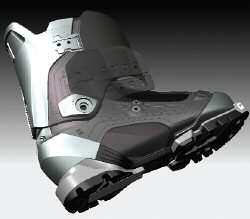 NX gave designers the ability to share some components among all nine new models. Here, the model reveals how softer plastic fits together with the stiff frame and the interchangeable hiking heel and toeblocks. |
“Fully integrated engineering and industrial design means that we needed both surfaces and solids as native parametric features within a model,” Hall continues. “NX, and particularly the powerful surfacing features in Shape Studio, provided the hybrid capabilities of surfaces and solids that the project required.”
The tight integration between the NX conceptual design and product design environments was key to optimizing the performance of the boot, a task that involved a lot of actual skiing and hiking in prototypes. “If someone came back and complained of pressure here or a pinch there, we could grab those surface points in Shape Studio and easily make a change,” Narajowski notes. “But those changes are not made in a vacuum. It’s not like we throw the design over the wall from industrial design to engineering and hope the design intent isn’t lost. We’re also using NX tools and the same geometry we create in NX Shape Studio to analyze the boot’s performance and to design injection molded parts. That is the real strength of NX for us.”
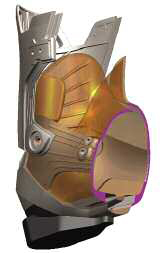 A cross-section of the Factor model illustrates the overlapping wrap design of the boot and how the external soft plasticfits to the stiff two-piece frame. |
International Collaboration
Engineers at the Black Diamond headquarters in Utah worked with their colleagues at the Black Diamond office in China on the design of the boot. The ability to share the workload in an efficient and accurate manner is another important benefit of NX on a project with the scope of the freeride boot, according to Narajowski.
“NX allowed us to break up the model and have more than one person working on it at a time,” he explains. “There would be an industrial design person working on outside surfaces, for example, while someone else was working on the foot shape or on the cutter for the buckles. People could work on their own parts, and then we could pull them in and automatically update the ‘super part.’ ”
Nearly all of the freeride boot project was performed using Siemens software. The integrated nature of the NX solution made it possible for the design team to go through the many iterations it needed. “We had to try a lot of iterations. We wouldn’t have been able to go through the iterations fast enough without tools like NX,” Narajowski adds.
Engineers started out by scanning feet, other boots, and old lasts to begin modeling. Then they started development of a boot last using Shape Studio and began modeling the boot frame.
The boots all have a mechanically integrated ski-walk mode that wearers can switch on or off at the back of the boot. It enables the ankle to flex when climbing and walking and to securely lock for descending. The mecahnism also offers eight degrees of forward lean in three settings. But what many skiers might find most interesting is that the heels and toes of the AT boots — like the top-of-the-line Factor — are interchangeable so a user can use the same boot to ski on typical alpine equipment at the resort or on AT equipment in the backcountry.
The boots have been previewed to the industry, received rave reviews, and sales are expected to begin in time for the approaching ski season. “As the largest, most expensive, complex development project we’ve ever undertaken, it’s hard to contain my enthusiasm about these boots,” says Peter Metcalf, CEO of Black Diamond. “They represent the best of Black Diamond today, exemplifying our design philosophy in terms of innovative product. Black Diamond boots will fully meet the demands of today’s freeride skier. We set out to build a better boot for the skier who wants one boot to rip all terrain and our design team has delivered.”
More Info:
Black Diamond Equipment Ltd.
Salt Lake City, UT
Siemens PLM Software Inc.
Plano, TX
Caren Potter is a freelance writer living in northern California. She has been writing about CAD/CAM for 20 years. Send comments about this article via e-mail to [email protected].
Subscribe to our FREE magazine, FREE email newsletters or both!
Latest News
About the Author
DE’s editors contribute news and new product announcements to Digital Engineering.
Press releases may be sent to them via [email protected].






